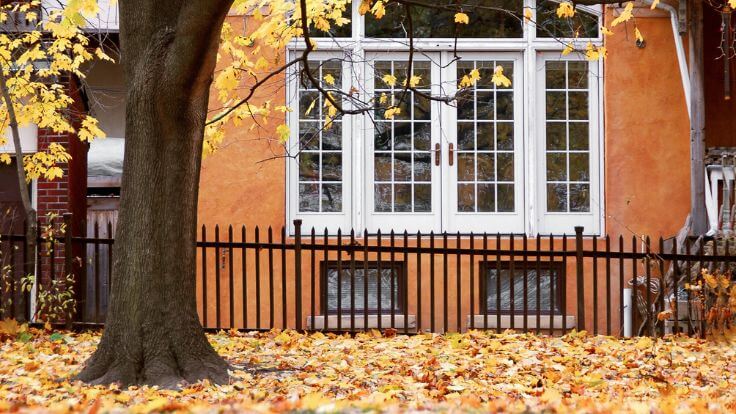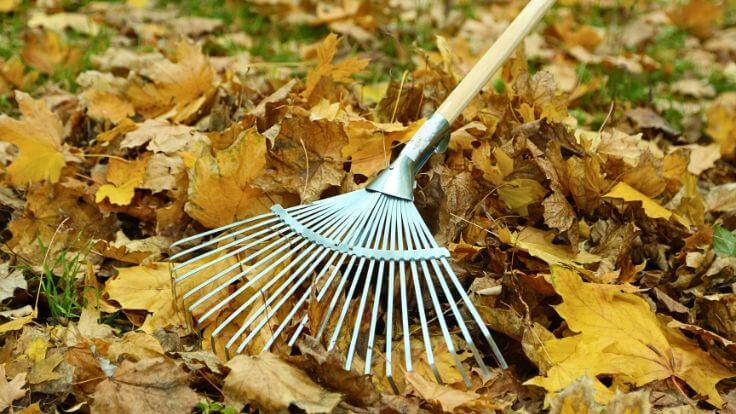Sweater weather is coming. Now is the time to prepare your home for falling leaves, cooler days, and – depending on where you live – winter storms. This fall home maintenance guide can help you keep track of things.
Wouldn’t it be nice if ALL we had to do to get ready for fall was hang a wreath and light some candles? Although that’s part of welcoming a new season – the fun part – there are other things to consider when you’re a homeowner.
“Tackling a few home maintenance tasks now can ward off issues later in the season,” said Jessica Bennett of Better Homes and Gardens. Plus, you get to enjoy everything you love about this time of year – relaxed and worry free.
Sound good? Let’s get started.
📋 DISCLOSURE – This page has affiliate links. If you buy something through one of these links, I may earn a commission at no cost to you. Read more here.
Your Fall Home Maintenance Guide
This is not a “one size fits all” guide. Homes are diverse in size, style, and location, and they have different maintenance needs. But this is a good checklist for most homeowners, and you’re smart to consider these tips as you prepare YOUR home for fall.
Most of these tasks are well within the average homeowner’s ability. However, if you want to hire a professional to handle them, it can be well worth the expense. “You’ll save money in the long run by preventing costly (and potentially dangerous) damage to your home,” said Bennett.
There are three sections to this guide: interior, exterior, and yard. Together, they offer 35 tips to help you tackle your seasonal home maintenance tasks. Without further delay, let’s get ready for fall.

Interior Home Maintenance
It’s time to trade your light and airy fabrics for warm and cozy blankets. But getting ready for fall is more than swapping your curtains and changing the décor. Here are 19 things you can do inside your home to prepare it for autumn:
1. Check for Air Leaks
According to the United States Energy Department, heat loss – through windows and doors – accounts for 30% of your energy use. Seal cracks with caulking and weather stripping to keep your home warm and rein in heating costs.
2. Replace Old Windows
If your budget allows, replace your old windows with energy-efficient models. You could save up to 15% on your heating bills. When shopping for windows, look for two labels – ENERGY STAR®️ and National Fenestration Rating Council (NFRC).
3. Wash the Windows
Early fall is a good time to wash your windows, blinds, and screens. Gather your cleaning supplies, or use plain ole soap and water. You could also try an outdoor glass cleaning tool for a “streak-free shine in half the time.”
4. Change Window Treatments
Replace your lightweight summer curtains with heavier drapes to keep out the cold. Layering curtains – or pairing them with shades or blinds – could also make things warmer. The extra insulation can reduce heat loss by up to 25%.
5. Inspect the HVAC System
Hire a heating-ventilation-air conditioning (HVAC) professional to inspect your forced-air heating system. Schedule the inspection for late summer or early fall, before the cold weather arrives.
6. Change the Air Filters
Dirty air filters make it hard to keep your home at a comfortable temperature. Clean filters can reduce your energy use by 15%. Some homeowners change the filters once a month, but you could also use 90-day air filters.
7. Change Thermostat Settings
ENERGY STAR®️ recommends you set the thermostat between 70 and 78 degrees – and leave it there. Temperature fluctuation is an efficiency killer. For a scheduled approach to home comfort, consider using a programmable thermostat.
8. Inspect the Radiators
Radiators are more common in older homes. In the fall, bleed your radiators of trapped air, clean the surfaces, and check the controls. Look for leaks and damage, or call a professional service for inspection and maintenance.
9. Inspect Gas Heaters
Keeping your gas heaters in good shape is both a cost issue and a safety concern. Improper heater maintenance can cause toxic gas to leak into your home – or, it could just cost you more to operate. Check the heaters yourself, or have a professional inspect them.
10. Inspect the Humidifier
Dry air is tough on the skin and airways. It also makes wood prone to cracking. You AND your home benefit when you keep your humidifier in top shape during colder months. Have your central humidifier inspected, and keep your portable humidifiers clean.
Advertisement
11. Inspect the Fireplace
Clean up leftover ashes, dirt, and soot before you use the fireplace. Even if you rarely use the fireplace, check it for damage and debris. Inspect the flue, test the damper, and check for loose bricks and broken joints.
12. Inspect Wood Stoves
Look for cracks, holes, corrosion, and loose joints. Clean the stovepipe and replace it, if needed. Use approved wall protection and floor material. Make sure the safety features are installed according to manufacturer specifications.
13. Reverse Ceiling Fans
Energy costs rise as the temperature drops. You can save up to 15% on heating costs with the ceiling fans in winter mode. So reverse the direction of your fans to redistribute warm air and keep your home more comfy.
14. Inspect Safety Features
Replace the batteries in your smoke and carbon monoxide (CO) detectors. Replace your fire extinguishers, if needed. Discard or store flammable materials, household chemicals, and poisons properly. Contact the Environmental Protection Agency (EPA) for guidelines.
15. Review Emergency Plans
Hold a family meeting to review your family emergency plan (you can make one here). Know your safe spaces as well as the routes out of your home and town. Inspect your emergency kit (see this checklist), rehearse your plan, and practice it.
16. Rotate Area Rugs
Area rugs and carpets get lots of wear and tear from foot traffic and sun fading. Rotate your rugs and flip them, if possible, to help them last longer and look more uniform. Do it again in the spring.
17. Clean the Carpets
Fall is also a good time to clean your carpets. Open your windows to let in fresh air and speed up the drying process. The BISSELL Dual Pro Carpet Cleaner is great if you have pets. If you’re not comfortable using a machine like this, hire a professional to do the job.
18. Rotate the Mattress
Like rugs, mattresses get uneven wear over time. It’s smart to rotate your mattress at the start of each season. Alternate between side-over-side and end-over-end rotation. If your mattress is the no-flip type like our plush hybrid mattress, rotate it.
19. Wash the Bedding
Most of us have a regular wash schedule for our bed sheets. But we often forget about the bedspread, mattress pad, pillows, blankets, and other linens. Check the care labels on your bedding. Some items are machine washable, and others need dry-cleaning.

Exterior Home Maintenance
Falling leaves are pretty, but they have consequences for your home and yard. Preparing the outside of your home is just as important as making the interior ready for fall. Here are eight exterior maintenance tasks to consider.
1. Inspect the Chimney
When you clean your fireplace for fall, inspect the chimney, too. Or hire a chimney sweep to inspect it and remove the deposits. Make sure the flue cap is in place, test the damper, and check for loose bricks and broken joints.
2. Inspect the Roof
Few problems are more annoying for a homeowner than a leaky roof, and winter storms can turn annoyances into disasters. Inspect your roof for damaged or missing shingles. And check for damage to flashing around windows, vents, and chimneys.
3. Clean the Gutters
Gutters attract falling leaves and other debris, and clogs promote rust and corrosion. You could end up with exterior damage and interior (basement) flooding. So clean your gutters or replace them, if needed. Amazon Home Services can help.
4. Inspect Crawl Spaces
Crawl spaces are damp and humid, which can lead to mold, mildew, rotting support beams, and damaged floor joists. They are also a breeding ground for termites, roaches, mice, and spiders. Make sure the entrance to your crawl spaces are shut tight and sealed.
5. Protect Outside Faucets
If you live in a place that gets freezing weather, take steps to protect your outside faucets. Disconnect garden hoses, close shut-off valves, and drain the lines. Use styrofoam faucet covers to protect outside faucets.
6. Inspect Power Generators
Inspect your generator and get it ready for the months ahead. Ice, snow, wind, and freezing temps can lead to power outages, and you don’t want to be without power. Prepare your generators now, or call a professional service for cleaning and maintenance.
7. Tighten Porch Railings
Cold weather can loosen deck parts, so it’s a good idea to tighten loose screws and bolts before the icy season. Inspect your deck and porch, and take steps now to make your wobbly railings sturdy.
8. Paint the House
Fall days are ideal for working with exterior paint. A fresh coat of paint can spruce up your home and prolong the life of your siding and trim. If you can’t tackle a big project right now, paint your front door in a color you love.
Advertisement
Lawn and Garden Maintenance
Curb appeal is the most visible part of your home. It’s the first impression to neighbors, visitors, and potential buyers. Here are eight ways to prepare your lawn and garden for fall.
1. Prepare the Lawn
The things you do now can protect the health and beauty of your lawn for spring. So rake the leaves, dethatch the grass, and aerate your lawn and garden beds. Fall is also a good time to fertilize the grass, trees, and shrubs.
2. Store Lawn Equipment
Lawn mowing is a year-round event in Florida, where I live. If you live in cold environments, you get the winter off! This fall, drain and store your lawn equipment. It’s also a good time to sharpen your mower blades for spring.
3. Protect the Sprinklers
Does your lawn have an in-ground irrigation system? To prepare your sprinklers for freezing weather, follow the manufacturer’s instructions. Drain the system and protect it from cold weather damage according to guidelines.
4. Prep the Swimming Pool
When the temperature drops and the leaves start to fall, it’s time to close your swimming pool. It may be tempting to throw a cover on it and wait until spring. But if you winterize your pool in the fall, it will be good to go next summer.
5. Wash the Driveway
Pressure wash your driveway and walkways. Hire a professional service, or do it yourself. Use a degreaser to clean stains as soon as they happen. And sweep leaves often, as they can trap moisture that can damage concrete and asphalt.
6. Repair Driveway Cracks
Once your driveway is dry, it’s time to fix the cracks. When water seeps into cracks, it can freeze and expand, making cracks bigger. Use asphalt, concrete, or vinyl concrete patching to fill the cracks and prevent future ones.
7. Lights the Walkways
Add lights to your walkways to prevent falls. Built-in path lighting is a good choice, but you could also use solar-powered path lights. Or, mount lights on your trees to provide downlight for your paths.
8. Create a Cozy Space
To enjoy everything the season has to offer, create a cozy lounge area on your deck, patio, or lanai. Start with comfy seating, then add some accessories – a wood burner, fall pillows, or a basket filled with blankets.
Conclusion
There are SO many things you can do to make your home ready for autumn. This fall home maintenance guide is a good place to start. Tackle the necessary tasks now, then relax and enjoy the cozy season. ◻️
Related Posts
- 5 Ways to Make Your Kitchen Sparkle and Shine
- 8 Easy Ways to Make Your Home Ready for Fall
- 15 Thanksgiving Quotes That Will Inspire Gratitude and Joy

Now It’s Your Turn
Thank you for reading my post. Now it’s YOUR turn to chime in. Will you use a fall home maintenance guide for your seasonal tasks? Which job will you tackle first?
Let’s fill the comments with friendly conversation. Scroll down to leave a reply, ask a question, or just say hello. And if you liked this post, please give it a share.
Blessings, Annette
📋 NOTE – You are reading “Your Fall Home Maintenance Guide: 35 Tasks to Consider” on Savoring Home. First published in September 2023, it was updated in October 2023.
Photo Sources
- Dave Logan / Getty Images Signature, Bogdan Sonjachnyj, Elana Photo | Canva | License
- Pixel-Shot Studio / Canva
Reference Sources
Advertisement

Great article! Also, don’t forget to insulate your water heater and pipes, which is especially crucial for areas with cold winters. Insulating your water heater and its pipes can help reduce heating bills by minimizing heat loss, which means your water heater doesn’t have to work as hard or as frequently to maintain the desired water temperature. It will also minimize the risk of frozen pipes and potential water damage.
Excellent tip. Thank you for sharing! 🙂
Thank you for sharing such valuable information. However, it’s important to note that the lifespan of an air filter can vary depending on its type. Therefore, referring to the manufacturer’s manual for specific replacement guidelines is recommended. A straightforward visual check of the filter can also be informative. If the filter is visibly clogged with dust and debris, it’s likely time for a replacement.
Thank you for sharing this helpful tip. Have a Merry Christmas and a Happy New Year!
An important tip for fall home maintenance is to insulate your pipes. As temperatures drop, unprotected pipes are at risk of freezing and bursting, which can cause significant water damage. Adding insulation to exposed pipes, especially those in unheated areas like basements and attics, helps prevent this and ensures your plumbing system remains in good working order throughout the colder months.
Thanks for the tip, Ace. As others have mentioned here in the comments, insulation is an important tip for fall home maintenance. And those cooler autumn months will be here before we know it!
One more important tip for fall home maintenance is to flush your water heater. Over time, sediment builds up at the bottom of the tank, reducing the efficiency of your water heater and potentially causing damage. Draining and flushing the water heater annually helps remove this sediment, ensuring that your heater operates efficiently and lasts longer. This simple maintenance task can improve your heater’s performance and save on energy costs, especially as you prepare for the colder months.
That’s one home maintenance task we don’t often think about. Thanks for the tip!
Yeah, water heater maintenance is important. Unfortunately, it’s something that many people neglect. By the way, tankless water heaters are less prone to scale buildup compared to traditional tank heaters. This is because tankless water heaters heat water on demand, minimizing the continuous exposure to hard water minerals that cause scaling. Although tankless water heaters still require descaling, it is needed less frequently, making them a more efficient and lower-maintenance option
Hi, Kelly. Excellent tip. Thanks for sharing!